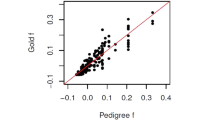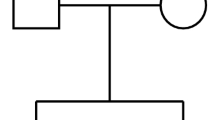Abstract
The ITO method ofLi & Sacks (1954) is extended to “simply closed” inbreeding systems. Two new matrices I* and D are introduced. These matrices give the probabilities of descendent genotypes when the ancestor is given and vice versa. The computations of the transition matrices are made less cumbersome by the introduction of an operator-method. The results are extended to multiple alleles (section 2) and to sex-linked loci (section 3). As applications, the computation of genetic correlations (section 4) and of unconditional probabilities (section 6) are considered.
Similar content being viewed by others
References
Browne, E. T. (1958). Introduction to the theory of determinants and matrices. Chapel Hill, Richmond, Virginia.
Li, C. C. &L. Sacks (1954). The derivation of joint distribution and correlation between relatives by the use of stochastic matrices.Biometrics 10: 347–360.
Malécot, G. (1948). Les Mathématiques de l'hérédité. Masson et Cie., Paris.
Author information
Authors and Affiliations
Rights and permissions
About this article
Cite this article
Richardson, W.H. Frequencies of genotypes of relatives, as determined by stochastic matrices. Genetica 35, 323–354 (1964). https://doi.org/10.1007/BF01804897
Received:
Issue Date:
DOI: https://doi.org/10.1007/BF01804897




